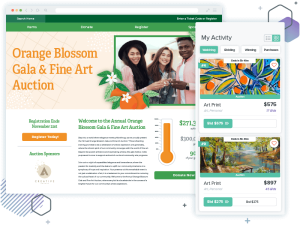Silent auctions are a classic go-to fundraising event, and for good reason. Guests bid on items, have an exciting time with friends and neighbors, and go home with a valuable prize.
From large in-person events to casual virtual gatherings, fundraising silent auctions can generate much-needed revenue and strengthen donor relationships.
To run a silent auction, you’ll need to plan many logistics, such as how guests will bid on items, what items you’re procuring, and how you’ll process donations.
If this seems like a tall order, don’t fret! You’ve come to the right place to learn how to plan a silent auction. This guide will walk you through:
How to run a silent auction: 11 steps to success
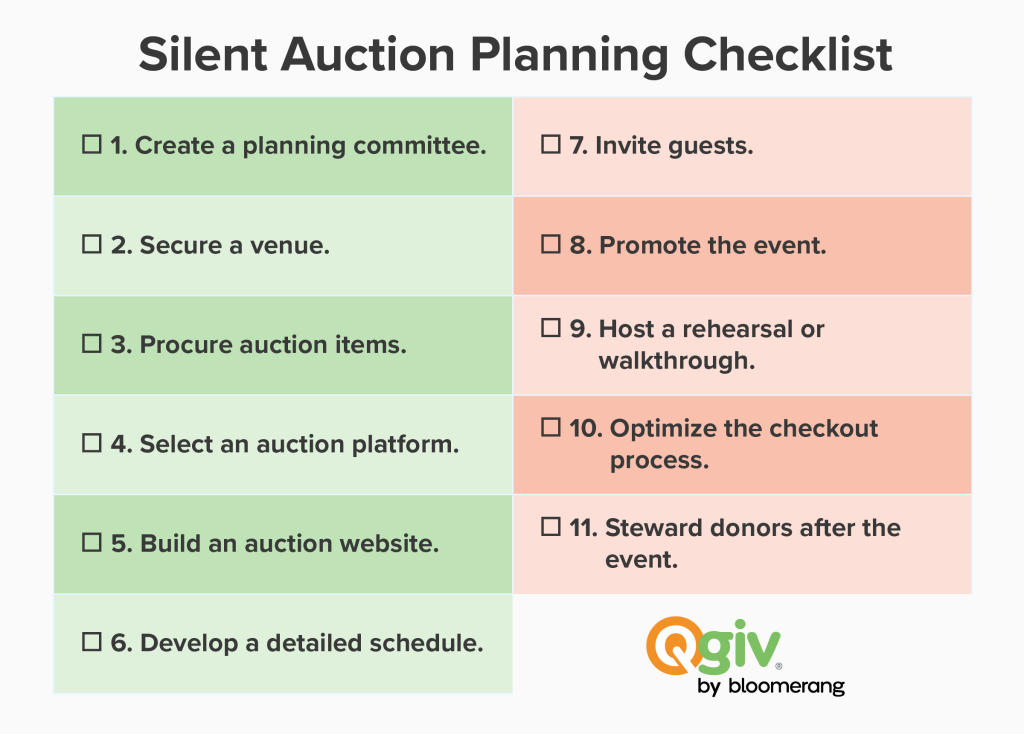
1. Create a planning committee.
Before you dive into the nitty-gritty of auction planning, gather a dedicated group of staff members and volunteers to form a planning committee.
This committee will be responsible for:
- Setting goals for the auction. Set both revenue and performance goals. To determine these target metrics, review past event results. Some common key performance indicators (KPIs) to look out for when analyzing past events are an increase in attendees/donors, the percentage increase of new donors, and the percentage increase of donors attained.
- Deciding whether the event will be in-person, virtual, or hybrid. While in-person events are the most engaging experience you can offer, incorporating virtual or hybrid elements offers convenience and expands your auction audience. Virtual or hybrid options are especially useful for organizations with worldwide audiences.
- Determining the auction budget. While silent fundraising auctions can raise a lot of money for your organization, they can also be costly to host. In addition to your fundraising tools, in-person venue, and auction entertainment, you must consider the price of procuring items and paying staff. To set an accurate budget for this event, assess past event budgets for similar experiences. If you need to budget more conservatively, recruit more volunteers to support the event or gather more in-kind donations rather than purchasing auction items yourself.
The characteristics of your planning committee will vary depending on your organization’s size. Larger organizations might have a team dedicated to planning silent auctions, with one or two staff members assigned to each task. On the other hand, smaller organizations may have a more limited committee with just one or two people in charge.
2. Secure a venue
Now that you have your planning committee, it’s time to determine where and how your fundraising silent auction will occur.
Finding the right venue for your event style, whether in-person, virtual, or hybrid, is essential.
Here are additional venue considerations you’ll need to think about:
- What equipment requirements do you need for the event?
- If the event is virtual, where will you set up the livestream?
- If the event is hybrid, how will you bridge the gap between virtual/in-person participants?
Besides determining logistics for where your silent auction will take place, you might also need to plan catering and entertainment. Some venues offer catering as part of their event space rental package, while others allow you to bring in external vendors.
Similarly, you’ll need to find entertainment that matches your event needs. Some options for in-person and virtual events are concerts, stand-up comedy shows, speeches, and other experiences that you can easily livestream.
3. Procure auction items
Gathering auction items is one of the most important steps when planning your silent auction fundraiser. This process involves various elements, from determining which items excite supporters to procuring these items and finalizing your budget.
Here are some tips to consider:
- Reach out to sponsors or partners for auction prizes. These may be physical items or experiences. For instance, you might partner with a local restaurant to auction off a free four-course meal or a wine shop to offer bidders a wine and charcuterie basket.
- Choose auction items that relate to your event theme. Let’s say your auction will fund increased educational opportunities for students in need. You might auction off laptops, school supplies, and other similar items. For instance, the American Herbalists Guild hosted a virtual auction with items like an herbology 101 course and a gift card for botanical medicine.
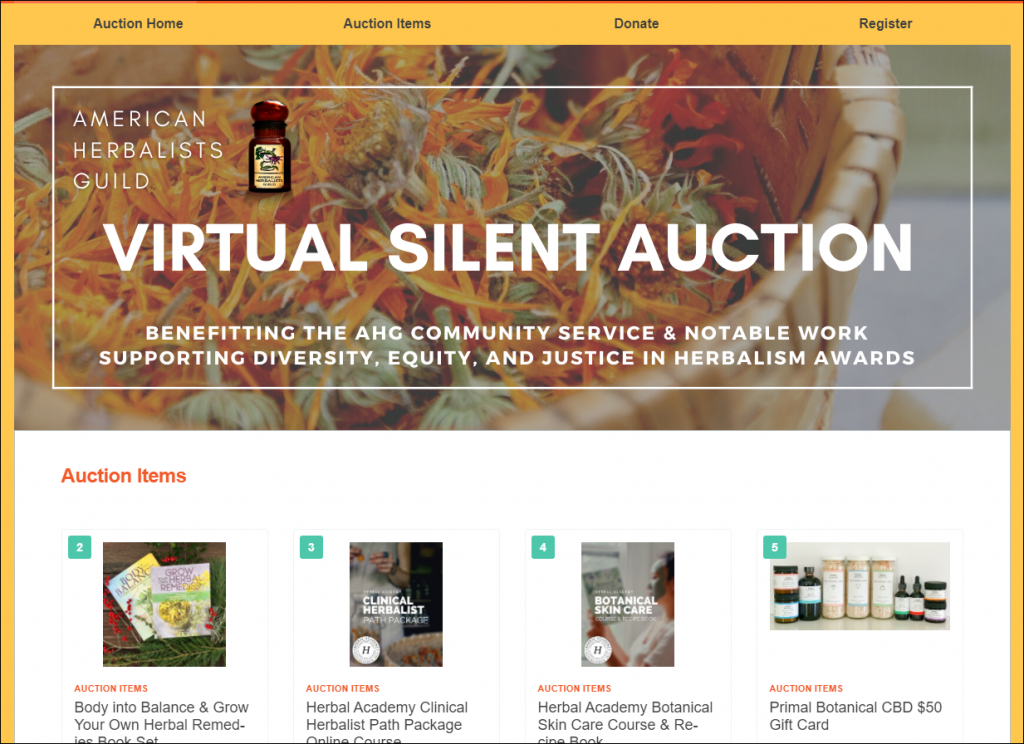
- Create a plan for storing and cataloging auction items. For instance, you and your planning committee should photograph or record each item you plan on auctioning off and write a description. This documentation is helpful for organizational reasons and also aids your event if you’re incorporating virtual elements. Plus, you can use these photos in your social media posts to promote the event and entice your followers to get involved.
- Set auction items starting bids at around 25-30% of the fair market value. This allows participants to win the item below its value and incentivizes them to bid. However, there are always exceptions to the rule. Explore our dedicated article to learn more about setting starting bids and increments.
The auction items and prizes you choose will motivate your supporters to bid, so you must gather a good collection that sparks participants’ interests.
4. Select an auction platform
Nowadays, it’s rare to see an auction rely on the old-school method of paper bids.
A fundraising auction platform will automate many of your planning tasks, increase convenience for your auction attendees, organize your participant information, and store all event data.
When investing in an auction platform, here are some key features to look out for:
- Mobile app-based and web-based bidding options so guests can choose how they want to participate
- Integrations with your existing nonprofit tech and constituent relationship management (CRM) system to enable seamless data transfers
- Unlimited auction participants so your future auctions can grow as your organization does
One of the greatest benefits of auction platforms is their ability to increase fundraising efficiency. For example, the nonprofit Feeding South Florida ran into issues using multiple fundraising platforms, including Eventbrite, Blackbaud, 32 Auctions, Classy, and others, making fundraising more complicated than necessary. The organization increased its efficiency and event fundraising by 60% within six months by switching to a unified auction and fundraising platform.
Our recommended solution: Qgiv by Bloomerang’s silent auction platform
The Qgiv fundraising platform has a dedicated solution for auction planners. Our platform eliminates the stress of paper bidding and long checkout lines. With Qgiv, you can:
- Leverage the mobile bidding app and keep attendee data in one place.
- Create branded event pages for virtual, live, and hybrid events.
- Send attendees notifications when they’ve been outbid.
- Manage event registration, check-ins, bidding, and checkouts from one centralized platform.
- Accept donations during the event registration process to facilitate even greater fundraising results.
- Simplify checkout for guests, who can view and pay for auction items won, donations, and other purchases in a single transaction.
- Enable multiple payment methods, including credit card, Apple Pay, or cash and check payments through the Virtual Terminal.
- Review registration, purchase, donation, and bidding reports in a customizable dashboard.
This solution simplifies the auction experience for planners and attendees, reducing stress and facilitating more efficient fundraising. In fact, with the help of Qgiv by Bloomerang, one organization raised 130% of its gala fundraising goal after switching from Greater Giving! Read more successful auction stories on our case studies and testimonials page, and learn more about our solution in this video:
5. Build an auction website
Whether your silent auction fundraiser is virtual or in person, you will need a dedicated website.
Your auction website is the first place prospective supporters will go to learn more about the event and where current supporters will go to register. As one of your most valuable marketing tools, your auction website should feature effective branding and handle all necessary functions.
For instance, your website should have a dedicated logo or banner that showcases your auction’s goals and illustrates your organization’s core mission. In addition, the site should describe your fundraiser’s expected impact to showcase your organization’s worth and incentivize donors to give more.
Along with effective branding, here are the core functions that your silent auction fundraiser website should perform:
- The option for donors to cover the online processing fee
- Dedications so donors can dedicate their gift to a specific person
- Recurring donation prompts
- Mobile responsiveness so that supporters can engage on the go
Here’s an example of a Totally ’80s-themed auction website, where supporters can register, browse items, and share the event on social media:
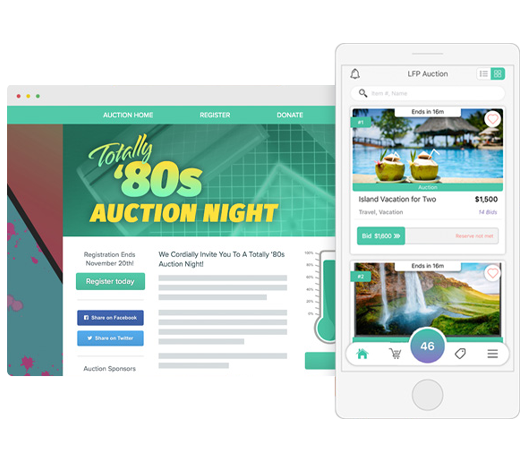
In addition to showcasing your auction items and facilitating registrations, ensure your website can host “fund-a-need” items.
“Fund-a-need” items are widely popular for silent auction attendees who want to support the cause but can’t necessarily afford to bid on one of the more lavish items. These aren’t prizes that participants take home but are smaller-dollar donations that provide tangible items for your cause. For example, if your organization is an animal shelter, you could give donors the option to fund purchases of dog food, leashes, collars, and dog beds for your organization.
6. Develop a detailed schedule
Now that your planning committee has sorted out most of the logistics, it’s time to implement your plan.
To ensure everything stays organized and that your silent auction goes smoothly, create a detailed schedule written out two to three months in advance. Include staff assignments and determine the number of volunteers you need to help manage each task.
Your action plan also needs dedicated guidance detailing team member responsibilities for the day before, the day of, and the day after your silent auction fundraiser. Define everything from who is responsible for checking in attendees to who will manage your follow-up thank-you strategy for attendees and donors.
Don’t forget to also create a contingency plan in case of any kind of emergency. For instance, your virtual event could have unexpected technical difficulties, or weather may threaten to ruin your outdoor event space decor. Walk through different scenarios for your event and ensure you have backup plans for worst-case outcomes.
7. Invite guests
It’s finally time to announce your silent auction fundraiser and jumpstart registrations. Before you launch any dedicated event promotion strategy, start inviting guests from your existing supporter base or past event attendees.
When your auction platform integrates with your other nonprofit tools, you can leverage your CRM to:
- Find and send invites to past event attendees.
- Send specific invitations to those on your email list who haven’t attended an event or donated in the past.
- Separate those who will receive email invites from those who will receive direct mail invites. Remember, your supporters may have a communication preference, or you might want to send physical mail (perhaps even a handwritten note) to your major gift donors.
With your auction platform, CRM, and marketing tools working together, you can create targeted messaging and ensure your communications resonate with supporters.
In all of these invites, make sure there is a clear, direct connection to how to register. This can be a URL, link, or even a QR code.
8. Promote the event
Besides emailing past attendees and creating a dedicated silent auction event website, take additional steps to spread event awareness using your other marketing channels.
Social media is a particularly effective platform for spreading event awareness because it can connect you to current supporters and potential new audience members. Your planning committee needs to consider what kind of posts create engagement and how to further your reach online. Explore the following ideas:
- Consider creative social media ideas like short-form videos on TikTok.
- Review past social media engagement and determine which posts and strategies got the most responses.
- Ask sponsors to promote your event on their social media channels. To make this process easier, provide graphics or dedicated videos for sponsors and partners to share themselves.
- Engage your guests on social media and encourage them to post their own content. Make your posts shareable so that supporters can easily repost them to their personal networks. You might even create a dedicated event hashtag for them to use.
Let’s see how social media can support your silent auction with a real-life example. Art & History Museums Maitland planned a virtual three-day online art auction. To promote their event and advertise specific pieces, A&H Maitland used their active Instagram profile to engage with supporters and answer their questions. Check out their Instagram homepage below:
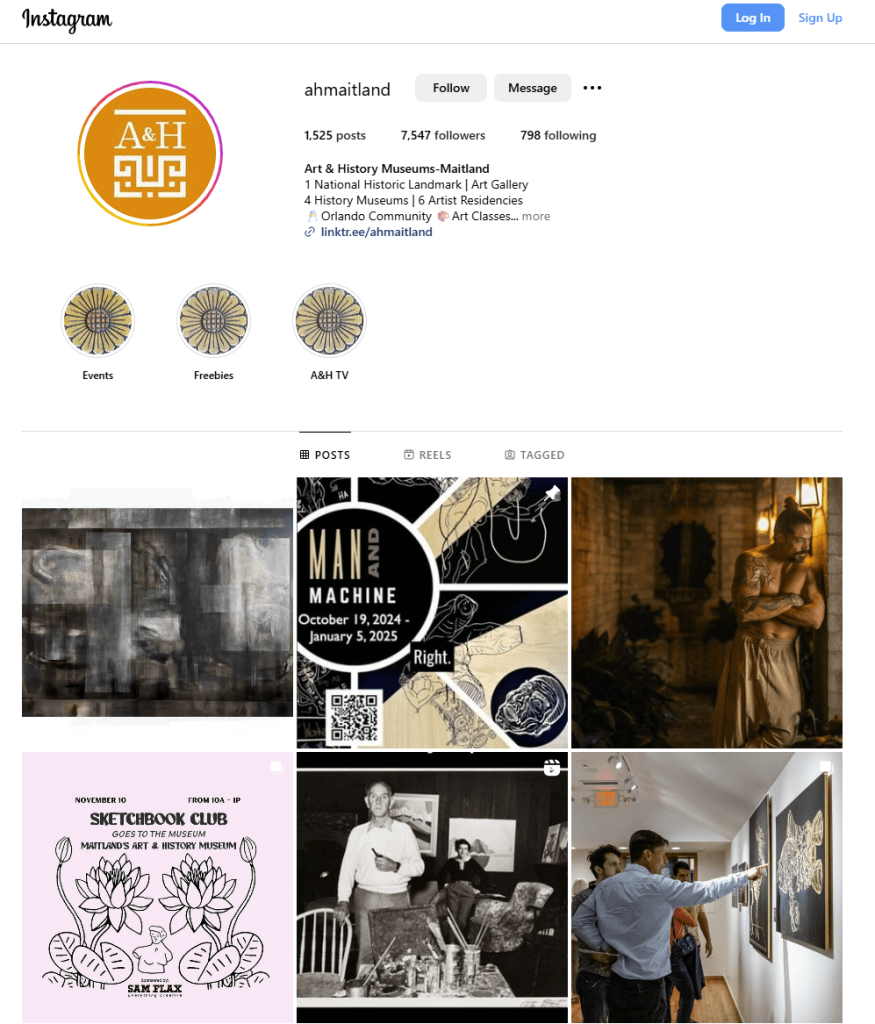
Along with leveraging social media to promote your silent auction, consider these other marketing tactics:
- Reach out to the press. Consider advertising your event in the weekly event lists in local newspapers. Contact local blogs or even the Chamber of Commerce to promote your event.
- Continue to use email. In addition to inviting past attendees, send a broad email to promote your upcoming event. You might even ask sponsors to send emails to their own contact lists. Provide text and graphics so that sponsors know exactly what to send.
- Go old school. Not everyone who wants to attend your silent auction is tech-savvy. Bolster your digital promotions with physical flyers and posters in well-traveled areas around your community. You can even ask local businesses to hang these flyers for you.
Your fundraiser’s marketing strategy can make or break your event’s overall success. Use multiple channels and take insight from past data and metrics for guidance.
9. Host a rehearsal or walkthrough
Remember how we mentioned the importance of a contingency plan? While you must have one, you should do all you can to avoid actually having to use it.
This is where rehearsals and walkthroughs come in. This type of preparation is especially crucial if you’re hosting a virtual or hybrid silent auction for the first time. When you walk through the event a few times, you can better pinpoint areas needing improvement and troubleshoot problems before they happen during the auction.
After your rehearsals and walkthroughs:
- Create an FAQ sheet for staff/volunteers based on common points of confusion.
- Determine the guest check-in and item check-out process.
- Ensure all staff and volunteers are familiar with the auction platform and mobile tools to check guests out and take online payments safely.
- Create a list of “VIP” attendees, such as your major donors. Your staff and volunteers should make a point of personally interacting with these individuals during the event.
You never know what can happen during an event, so walking through various scenarios is the best way to ensure your team is prepared for whatever may come.
10. Optimize the checkout process
Long checkout lines are frustrating for guests. After the excitement of the event, attendees want to quickly claim the items they won and head home to enjoy them.
However, the traditional silent auction checkout process isn’t as efficient as it could be. Between deciphering handwriting on paper bid sheets and slow payment processing on computers or registers, the process could be significantly delayed, leading to long lines and agitated guests.
By incorporating silent auction software into your event, your checkout process will look more like this:
- The auction ends.
- Your organization opens checkout.
- Guests who have already entered their payment method can easily pay for their transactions, such as bidding items, event purchases, and fund-a-need items.
- Guests will get a paid receipt, and the organization can scan their QR code to see a list of won items, which are then retrieved and handed to the guests.
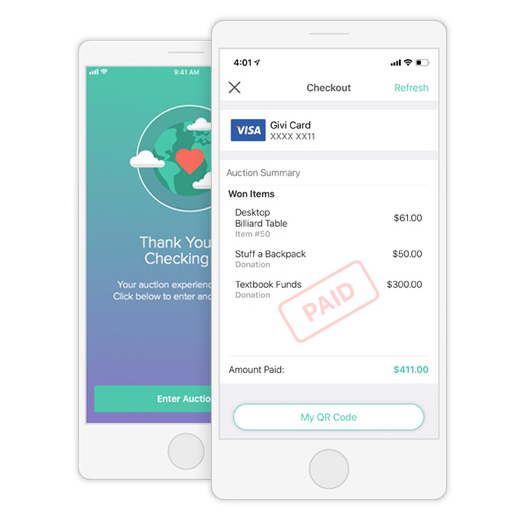
Using silent auction software reduces checkout lines, speeds up checkout times, and gives your staff and volunteers more time to retrieve the items for bidders.
11. Steward donors after the event
Did you know the average donor retention rate hovers around 40-45% across the nonprofit sector? In fact, 70% of new donors will only give once.
If your silent auction fundraiser attracts new supporters and introduces them to your mission, you should do everything possible to keep them around. One of the best (and easiest) ways to retain new donors is to follow up after the campaign.
Once the event is over, send thank-you emails to each of your participants. Explain how much you valued their participation and demonstrate donors’ impact on your mission. Often, people don’t give again because they don’t know what happened to their previous gift, so providing detailed follow-up is critical.
Along with increasing donor retention and starting new relationships on the right foot, following up with participants after your silent auction fundraiser allows you to:
- Let donors know how to pick up their winnings if they participated virtually or left the event early.
- Share your plans for items that didn’t sell, like saving them for a future auction or selling them online.
- Explain wins/losses/growth opportunities to supporters in a transparent way.
- Provide an opportunity for participants to give feedback with a survey or optional questionnaire.
Ultimately, following up after the event is a great way to continue the relationship with current and new donors.
Silent auction rules and best practices
Learning how to run a silent auction means understanding the rules and best practices. Common silent auction rules and guidelines include:
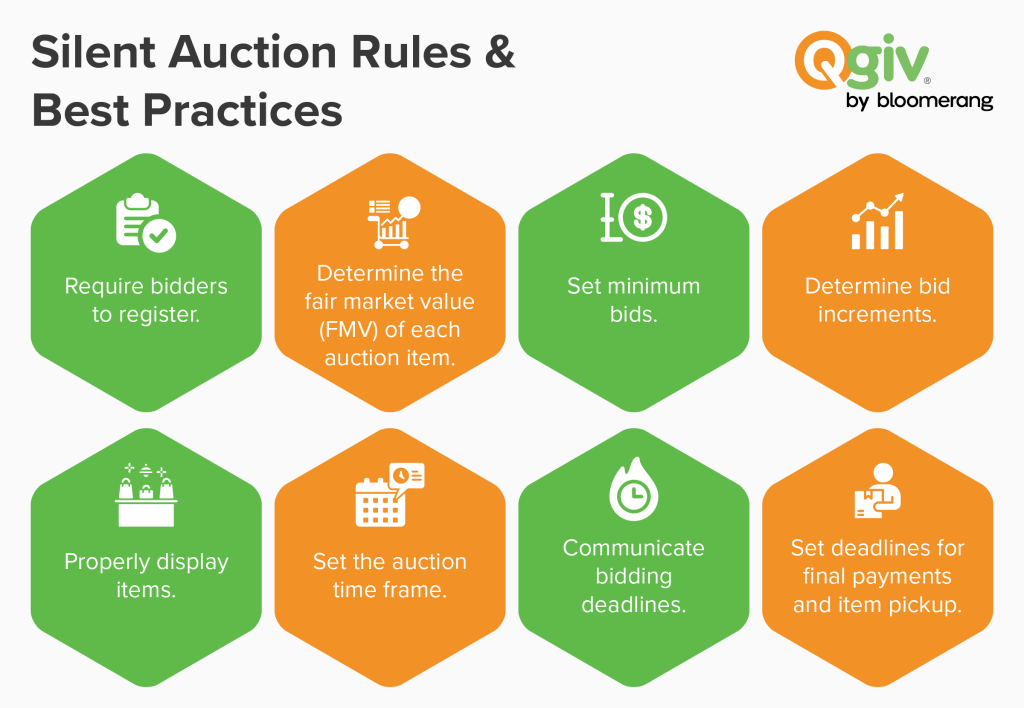
Require bidders to register
Requiring guests to register helps you understand exactly which supporters will attend your event and create personalized engagement plans, especially for major donors. Encourage them to register in advance with early-bird discounts and other incentives, like early access to bidding. At the actual event, create multiple check-in lines. For example, you can have a VIP line, a line for those who pre-registered, and a line for walk-ins.
Determine the fair market value of each auction item
Conduct extensive research to determine your auction items’ fair market value (FMV). Check the internet for similar items, see if you can get an expert opinion (or two), and list the FMV based on your research. The more accurately you assess these items, the more value you’ll give your guests.
Set minimum bids
To set a reasonable starting bid for each auction item, you must first determine its FMV and decide on your minimum bid as a percentage of that. If the starting bid is too high, you might not attract enough bidders. On the other hand, if it’s too low, you may leave money on the table. Consider what bidders would be willing to pay for the item in a typical setting and go from there.
Determine bid increments
Keeping bid increments lower will increase the volume of individual bids, while higher bid increments will encourage fewer people to place a higher bid. It’s about striking a balance and considering the item up for auction. Additionally, when you incorporate a mobile bidding app, it’ll be easier for bidders to place a higher bid because they can do so from their phone with a few taps, increasing the number of bids you receive!
Properly display items
Avoid small and overcrowded silent auction item displays, poor lighting, or handwriting on display sheets. Instead, display everything like you would in a retail shop, keeping it well-lit and using detailed display cards. Ensure every item is in your mobile bidding system, and, if possible, keep items out of their packaging for a better view.
Set your auction time frame
Open your auction as early as possible, even days in advance. This gives guests more time to familiarize themselves with your items, learn how to use your auction tools, and get ready to bid once the auction starts. Then, close the auction as late as possible on the event day.
Communicate deadlines for making a bid
Develop a system to communicate the time left for guests to place their bids. Announce the time remaining before closing times. If you’re using an app-based auction product, you can create and send push notifications to all attendees. This helps boost engagement and encourage more friendly competition in the minutes leading up to the conclusion of the auction.
Set deadlines for final payments and item pickup
Set clear deadlines for making final payments and picking up items. Silent auction software can streamline this process; guests can easily pay and checkout after the evening. However, if a guest chooses not to pick up the item, you’ll have the data to identify the second-highest bidder.
Final thoughts
With these tips and best practices, you can dive into silent auction planning. This process is easier with the right tools on your side, like Qgiv’s silent auction platform.
Looking for more resources to support your auction planning? Start with these comprehensive guides:
- 15 Silent Auction Software Tools to Power Your Events. Explore top silent auction platforms to choose the best one for your nonprofit’s needs.
- The Expert Volunteer Management Guide for Savvy Nonprofits. Understand the best ways to recruit and engage event volunteers with this volunteer management guide.
- The Busy Fundraiser’s Guide to Multi-Channel Event Marketing. Learn additional strategies for using multiple marketing channels to promote your silent auction.




